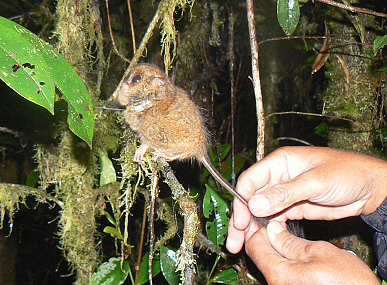Tiny monkey re-emerged after 86 years
On a foggy mountain peak on Indonesia's Sulawesi island, scientists discovered one of the smallest and rarest primates on the planet, Tarsier dwarf monkey.

Tarsier dwarf monkeys are about the same size as tea cups.Photo: Livescience.
Weighing about 60 grams, Tarsier dwarf monkeys (full name Tarsius pumilus) are only as small as mice and have large eyes. They have a thick coat to keep it warm in a cold and wet environment. Instead of having nails and toenails like other primates, pygmy monkeys possess curved claws to cling to moss-covered trunks.
The last time a dead Tarsier was seen occurred in 1921. Years later no one saw them and scientists thought Tarsier monkeys were extinct. Then in 2000, two Indonesian scientists accidentally killed a Tarsier while trapping rats in Rore Katimbo Mountain in Lore Lindu National Park, Sulawesi. But many experts do not believe that Tarsier monkeys exist.
Thus, Sharon Gursky-Doyen, a biology professor at the Texas Agricultural and Mechanical University (USA), and a student named Nanda Grow came to Sulawesi to search for Tarsier dwarf monkeys. They hired a few local people to lead the way. In the summer of last year, the group trapped three Tarsier (one female and two males). They wear a signal-mount device to their neck to monitor. Since dwarf monkeys can rotate their heads at an angle of 180 degrees, wearing belts on their necks is not an easy task.
'I have the honor of being the only person in the world who was bitten by a tarsier,' Sharon said.
Tarsier is the most exotic mammal in the primates (including lemurs and humans). They feed at night and live only on some islands in Asia.
- The tiny monkey is just 10cm taller
- 40 interesting facts about monkeys that you don't know yet
- Discover new monkey species in the Amazon rainforest
- Not only humans, many monkeys have entered the Stone Age from 3000 years ago
- Monkey Actinidiaceae - Super grade fruit
- Found monkey thought extinct
- Found the oldest fossil monkey in America in Panama
- Shocking discovery of monkey's memory
- Renovate shopping centers, discover mysterious monkey mummies
- Do monkeys eat bananas?
- The first time successfully extracted the mysterious monkey species DNA in Jamaica
- 'Monstrous' in nature: Japanese monkeys do 'that' with ... deer
 Animal 'suffering' after hibernation
Animal 'suffering' after hibernation Why do goats climb well?
Why do goats climb well? Scientists were surprised to see chimpanzees eating turtles
Scientists were surprised to see chimpanzees eating turtles Giant catfish died deadly due to drought in Thailand
Giant catfish died deadly due to drought in Thailand